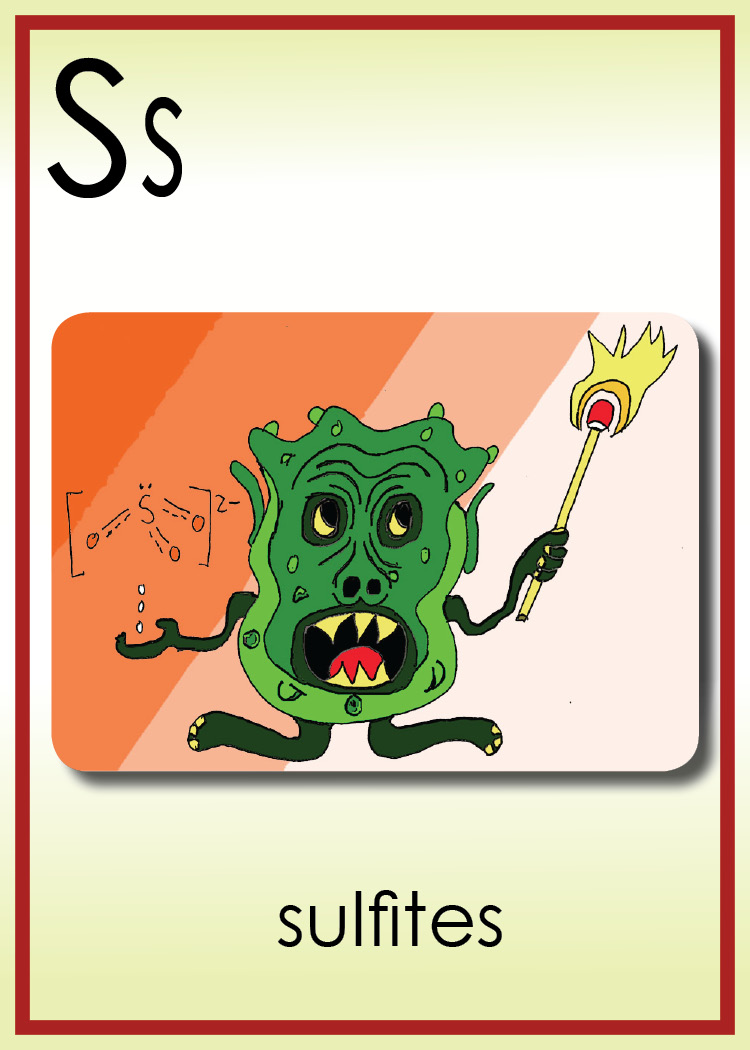Now I Know My Wine-Phabet: S is for Sulfites
In this new series called “Now I know my Wine-phabet”, I will explore letter by letter wine and what I believe are some of the most important and/or influential aspects in the world of wine. Since I am only choosing one topic per letter, many will be missed. Hopefully these posts come across as being whimsical and informative.
Ahhh Choo…sniffle sniffle…cough cough….itch itch…”Ouch my head hurts”!
Sounds like someone is getting sick. It is getting close to Halloween and the temperature is changing. Or maybe they drank a glass of red wine last night which contained…Da Da Da Da Dun! (Symphony #5)… SULFITES!
Those menacing evil sulfites, what are they!? Why do they get me sick? These microscopic creatures cause me to get allergies such as rashes and headaches. Worst of all they always ruin a good time.
If we look back in time to find their creator, or better yet, their Dr. Frankenstein; we will see that these tiny beasts have been part of wine making since the beginning. Back in the day, the Dutch would light a match stick (sulfur) inside of new barrels before filling them with fresh wine. This allowed the wine to stay preserved during shipping.
Looking deeper into these demons, we see that they actually occur naturally as a by-product of yeast metabolism during fermentation. In a nutshell, sulfites keep wine fresh.
For all those that stay away from heinous red wines which contain sulfites here is a brief low down. Red wines are regulated to have no more than 160 parts per million of sulfites. Vicious whites have up to 210 ppm and insipid sweet wines have up to 400 ppm. Those delicious dried fruits we enjoy at our local organic farmer’s markets contain 1000 ppm.
So is it really the sulfites that are causing your allergies? Maybe it is the tannins and histamines in red wine. How about this Sherlock …ALCOHOL!?
Sulfites can cause reactions in some people if they are severe asthmatics or have metabolic problems and cannot break down sulfites. But it is rare that the symptoms would occur as headaches.
If wines did not contain sulfites wines would not last. Even natural wines which do not use sulfites need to be stored below 57 degrees and drunk young, otherwise they just don’t last. So if you keep your wine on your living room wine cabinet, I recommend you not worry about sulfites. Otherwise the rancid taste of bad wine might turn you away from wine altogether.
Sulfites are not that bad. If you suffer from allergies when drinking wine it can be a result of many other ingredients. So let’s be fair to sulfites. Try drinking un-fined and unfiltered wines of a lower alcohol level and see how you do.











6 Comments
Aaron
Well said, Maurice! Sulfites do indeed get a bad rap. One other thing that I always think is worth mentioning: sulfites are found in many common foods, not just wine. If you are truly allergic to sulfites the odds are that you know it already – you probably grew up unable to eat lunch meat and many other things! Maybe you just drank too much last night…
Sulphites: The Good, The Bad and The Ugly | Dr Wine
[…] I Know My Wine-Phabet: S is for Sulfites Posted on October 17, 2012 In this new series called “Now I know my Wine-phabet”, I will explore letter by letter wine […]
Winkmeister
Agreed. A storm of articles written by unknowing people blaming sulfites for reactions to wine spread this misinformation. Unknowing, in the sense that they may know a bit about wine, but little of organic chemistry and just want to crank out their word minimum to collect another paycheck.
What hasn’t been mentioned here yet is the federal labeling requirement for the words, “Contains Sulfites,” and its history. This, too, adds to consumer concern and misinformation.
The ppm threshold is such that many wines exceed this naturally. It is not an indication of them being added or used excessively or inappropriately, if at all.
— also, it is my recollection that it is the amine family, especially triamines, that are being studied and which the anti-histamine (smartly taken an hour or two before a wine dinner or tasting event) are helping to counter.
These recommendations are implemented individually; what may be a godsend to one could shut off the sense of smell from excessive drying in another. A partial dosage may be a complete solution.
Why work at this?? you’ll be eating the rest of your life and nothing enhances most dining experiences like wine.
To modify the good doctor’s advice, “take an aspirin and two large glasses of water and call me in the morning.”
[consult with YOUR doctor to see if anti-histamines or aspirin would cause their own problems for you]– and if your doctor is not a wine drinker, find another one.
Maurice
Thanks Winkmeister. Well put.
Dirk-Antoon Samyn
With all due respect Maurice, but you have to check a bit more your sources or to dig a little deeper! With Commission Regulation (EC) No 606/2009 of 10 July 2009 (!!) levels have been decreased to 150 for reds and 200 for whites, sweet ones staying on 400 mg/L! Dried apricots can/may contain up to 2000 ppm! It’s not really SO2 which is causing headaches but acetal-dehydes! And for the historical part, Romans already knew and used ‘natural’ sulfur, long before Dutch (preceded by the British!) burned candles! Try to avoid to spread incomplete information, please?
Maurice
Thanks for the added information. I am not sure how much you have followed my Wine-Phabet, but it is a way to give people a better understanding of wine in a whimsical and fun manner. The sulfites argument is a lot more complex for a post in the Wine-Phabet. It is interesting that I have received so many comments on linkdin regarding this topic. Everyone has an opinion and it’s great to see all sides of an issue. Your added information is helpful. If we can all agree, the basic information I am trying to convey is, sulfites MAY NOT BE the cause of your headaches. I appreciate your feedback. Cheers!